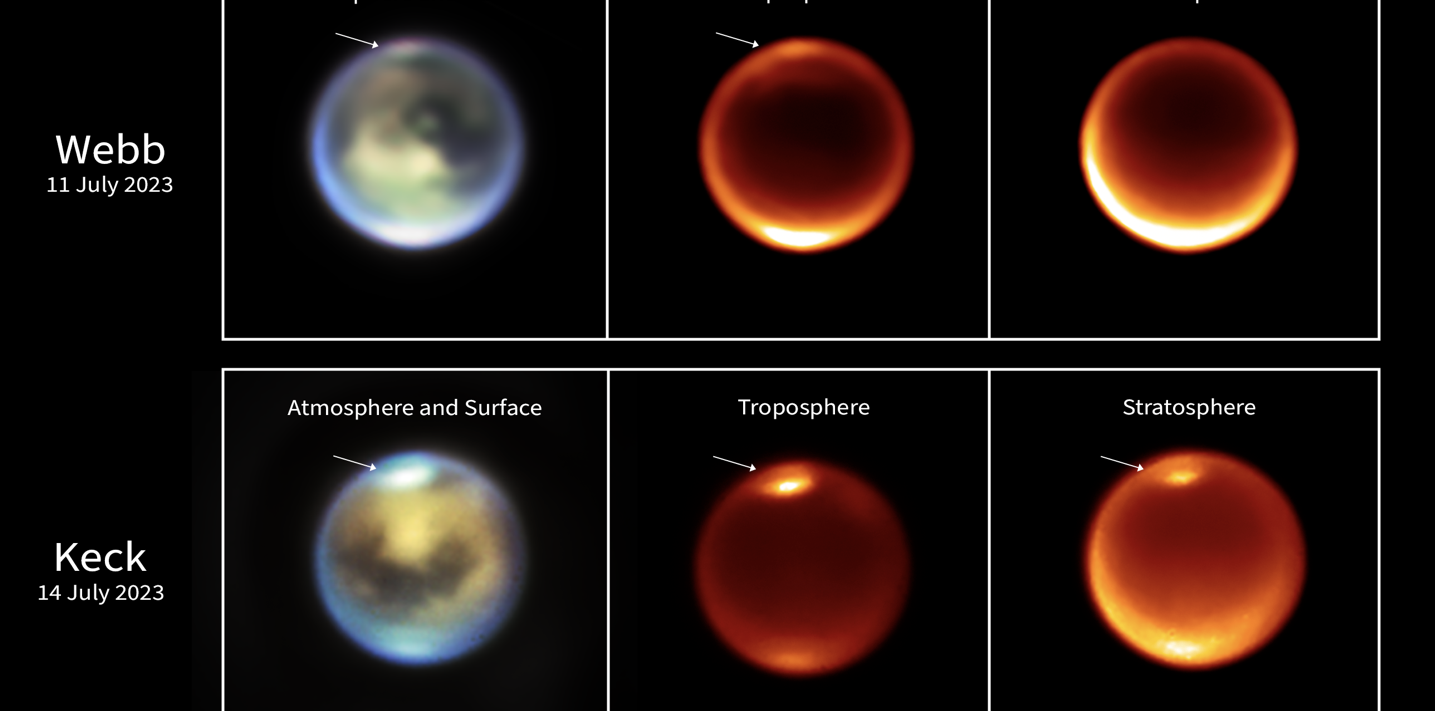Unprecedented Observations of Titan’s Atmosphere
The James Webb Space Telescope (JWST), in collaboration with the ground-based Keck II telescope, has made a groundbreaking discovery by observing cloud convection in the northern hemisphere of Titan, Saturn’s largest moon. This study, conducted by researchers from IPGP, offers new insights into the atmospheric dynamics and organic chemistry of this astrobiologically significant celestial body. The findings were published in the journal Nature Astronomy as part of JWST’s guaranteed time observation program.
New Data Reveals Titan’s Atmospheric Secrets
Data collected in November 2022 and July 2023 by JWST and the W.M. Keck observatories revealed the presence of methane clouds evolving at different altitudes in Titan’s northern hemisphere. Using specific infrared filters ranging from 1.4 to 2.17 microns, researchers probed several atmospheric layers, from the lower troposphere to the stratosphere. These observations captured vertical cloud movement, indicating sustained convective activity. The images show cloud formations rising between July 11 and 14, 2023, confirming for the first time a convection phenomenon at high northern latitudes. This type of observation is a major contribution to understanding Titan’s methane cycle and complex meteorology.
Methane-Driven Weather on Titan
On Titan, methane plays a meteorological role similar to water on Earth. It evaporates from lakes and seas, condenses in the atmosphere, and forms clouds, occasionally falling back as rain on an icy surface. The clouds observed are located in Titan’s northern hemisphere, where the main methane lakes are concentrated, covering an area comparable to that of North America’s Great Lakes. It is currently summer in this hemisphere. The ascent of clouds to altitudes reaching 28 miles (45 km)—significantly higher than the 7.5 miles (12 km) on Earth—illustrates the vertical dynamics of an extended atmosphere, made possible by the moon’s low gravity.
Advances in Cryogenic Organic Chemistry
Alongside these meteorological observations, the study has led to a major advance in the study of Titan’s organic chemistry: the detection of the methyl radical (CH₃), an unstable compound formed during methane dissociation. This molecule, previously undetected in Titan’s atmosphere, is a fundamental intermediate in reaction chains producing complex hydrocarbons. Its presence attests to Titan’s chemical richness, whose atmospheric processes could shed light on conditions favorable to the emergence of life. The ability to track these reactions “in progress,” rather than just their end products, represents a decisive step forward in understanding extraterrestrial organic environments.
A Fragile Atmospheric Cycle
The study also highlights the vulnerability of Titan’s methane cycle. Some methane transforms into heavier compounds that fall back to the surface, while another portion is lost when hydrogen escapes into space. Without deep sources capable of reinjecting methane into the atmosphere, it could become depleted over time—a phenomenon comparable to the water loss experienced by Mars in its past.
Preparing for the Dragonfly Mission
The results of this study are part of a scientific continuum ranging from the Cassini-Huygens mission (1997–2017) to the Dragonfly mission, planned for 2034. This NASA octocopter drone will perform successive flights on Titan’s surface to explore various sites and analyze their composition. Combined with data from major observatories (JWST, Hubble, Keck), the Dragonfly mission will significantly enhance our understanding of Titan and illuminate the physico-chemical conditions that may exist on other celestial bodies.
Key Discoveries and Future Implications
This research marks a significant milestone in planetary science, offering new perspectives on Titan’s complex environment. By studying its weather patterns and chemical processes, scientists can gain deeper insights into how similar conditions might exist on other moons or planets. The detection of methyl radicals and the observation of cloud convection represent critical steps toward understanding the potential for life-supporting environments beyond Earth. As future missions like Dragonfly prepare to explore Titan’s surface, the knowledge gained from these studies will play a vital role in shaping the next era of space exploration.







